Space Power is about the generation of power from space.
The space around Earth is filled with intense sunlight, undiffused by atmosphere, continuously. It represents an inexhausible supply of energy that can be converted to electricity using semiconductors - that is without the use of any moving parts.
A small fraction of this energy could supply a large part of the world's future energy requirements for the foreseeable future. In addition, it could do it without the need for any kind of fuel, and without producing any waste product.
All that's needed is large-area collectors - and that means large, thousands of square kilometers - and a way to transmit the collected power down to Earth. Several different methods are possible, but the one that has received the most effort so far is the use of microwave beams or wireless power transmission.- 29 July 2012
- Added "Space Debris and Its Mitigation
" to the archive.
- 16 July 2012
- Space Future has been on something of a hiatus of late. With the concept of Space Tourism steadily increasing in acceptance, and the advances of commercial space, much of our purpose could be said to be achieved. But this industry is still nascent, and there's much to do. So...watch this space.
- 9 December 2010
- Updated "What the Growth of a Space Tourism Industry Could Contribute to Employment, Economic Growth, Environmental Protection, Education, Culture and World Peace
" to the 2009 revision.
- 7 December 2008
- "What the Growth of a Space Tourism Industry Could Contribute to Employment, Economic Growth, Environmental Protection, Education, Culture and World Peace
" is now the top entry on Space Future's Key Documents list.
- 30 November 2008
- Added Lynx
to the Vehicle Designs page.
To receive announcements and news of updates by email, subscribe to the sf-announce mailing list.
Join the sf-discuss mailing list to ask questions and talk about space tourism, vehicles, power, and habitats.
More Info- Space-based Solar Power by 2016?
- When Stephen Hawking Speaks...
- Space-Based Solar Power, the PowerSat Way
- Space Frontier Foundation Submits SSP Whitepaper
- The 40th Anniversary of the Solar Power Satellite
- Mini-Documentaries on Space
- Why Space Solar Power Is Superior to Biomass Fuel
- Department of Defense Feasibility Study
- Space Solar Power Blog
- Global Warming...
- How Much Do You Know About Space
- Space Future Editor Wins NewSpace Journalism Award
- China's First Manned Docking of Space Module Is a Success
- Five Horrifying Facts
- NASA Will Pay You to Eat Astronaut Food
- Attention Teachers: If You Don't Apply to This Workshop
- Space Is Dirty
- The Film That NASA Banned
- SRI holds Inaugural Conference
- Zubrin's Proposal to Fund "Pathway to the Stars"
Here are some key documents from the archive to get you started:
- What the Growth of a Space Tourism Industry Could Contribute to Employment, Economic Growth, Environmental Protection, Education, Culture and World Peace
- Space Tourism Market Demand and the Transportation Infrastructure
- General Public Space Travel and Tourism
- Artificial Gravity and the Architecture of Orbital Habitats
- Prospects of Space Tourism
More Documents
|
| |
|
| |
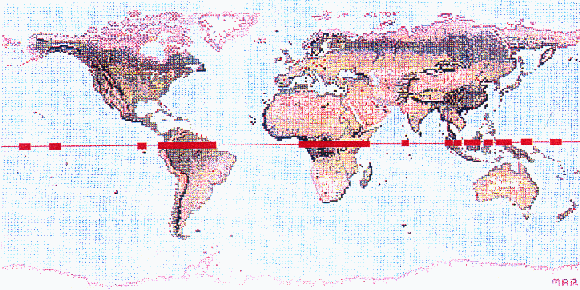 | |
|
So far, all the countries visited will participate in the SPS 2000 project. However, most of the equator is sea, and so the maximum utilisation rate which the SPS 2000 satellite will achieve, if all equatorial countries participate, as seems increasingly likely, will be about 40%.
Welcome to this Issue
This 5th issue of "Equatorial Times" is a Special Issue to mark the establishment of the Space Solar Power Research Society in Tokyo on October 31. For this occasion we are publishing articles by the incoming Chairperson of the new Society, Professor Hideo Matsuoka of RCAST, the previous Chairperson of the SPS Working Group, Professor Makoto Nagatomo of ISAS, and Yoshihiro Naruo of ISAS, a major contributor to the SPS 2000 system design, and organiser of the SPS 2000 display at the recent "Eco Japan '97" exhibition in Kyoto. The 6th issue of "Equatorial Times" will be published in June 1998, and will cover the topics originally planned for this Issue.
Space Solar Power Generation in Society
On the Occasion of the Inauguration of the Space Solar Power Research Society Professor Hideo MATSUOKA
Since the SPS Working Group was established in 1987 at the Institute of Space and Astronautical Science of the Ministry of Education, Science and Culture, it has conducted a range of studies on scientific and engineering problems relating to solar power generation satellites (SPS) and their potential impacts on the global environment. The progress of the Working Group's studies has been compiled and made public in the form of proposals for the inauguration of full-fledged studies of SPS. In 1991 a paper introducing the Working Group's conceptual design study of the "SPS 2000" pilot plant was given the Best Paper Award at the SPS '91 international symposium on power from space, raising the morale of the Working Group. As the concept of SPS and the related technologies that need to be developed became better understood, the recognition gained ground that it would be better to study SPS as an energy system to address global environmental issues rather than as a "space project". To be more specific, SPS should be studied as a space-based energy system for the benefit of the entire Earth, including its potential role in resolving issues of the survival of civilized society. Conceptually, in other words, it was upgraded from being a satellite power system for technologists to "a space solar power system to be incorporated into society." The SPS Working Group at ISAS was originally organized to work out a scientific satellite program; it was not a suitable organization for full-scale study of a space-based solar power generation system in society. For this reason, the Working Group was disbanded in the spring of 1997, in recognition of the fact that technologies required for space-based solar power generation should be developed not in the framework of space development but in the framework of new energy development. To balance this, the Space Solar Power Research Society, composed of researchers in a wider range of fields than the SPS Working Group, has now been inaugurated as a framework to carry out full-fledged study on space-based solar power generation as a power supply system. For the time being, the Executive Chairperson is based at the University of Tokyo's Research Center for Advanced Science and Technology (RCAST). If expressed in military terms, one could say that "..an action order has been handed down" to advanced macro-engineers. It is in this context that I am writing this paper. "Space solar power generation in society" will naturally face competition in the electricity market from other power supply systems in such matters as method, quality and volume. But the main issue to be addressed for space solar power generation is the price of electricity. Very roughly speaking, if the average price of electricity from hydraulic, thermal and nuclear power generation - the three major means of generation today - is taken to be about 10 Yen per kwh, the corresponding price for space-based solar power generation is estimated at some 1000 Yen per kwh - or 100 times as much as the former. At such a price level, power from space would be bound to be a failure in spite of being a "limitless energy source" and "friendly to the environment." It would be a mission impossible. 
The DC-X in flight
However, this high price is attributable not to the solar power satellite itself, nor to the power receiving "rectenna" sited on the Earth, but to the cost of space transportation, that is, to the high cost of transporting construction materials for SPS to their specified places in orbit. The cost of space transportation has to be reduced to approximately one 100th of its present level. Consequently a central question is whether this is possible. The cost of space transportation is maintained at a high level because it depends almost exclusively on the monopolistic requirements of the government - the same price setting mechanism as in the defence industry. Launch services are characterized by small demand and high price, and a fall in price would cause a shrinkage of the program. In such a situation, there is nothing to motivate the supply side of the space industry to reduce the price, while on the demand side the government is not willing to pursue price reduction leading to destruction of the space industry. Candidly, the space industry has become a public investment program to preserve employment. The same is true in the USA, where the "space program" is largely a means to fight unemployment in such states as Texas and Califomia according to the requests made by the governors and federal legislators concerned. The arising of this situation in both Japan and the United States is the outcome of government led projects continuing over several decades. Just as in the case of the logic used to revitalise the three postal businesses in Japan by privatizing them, if Japan Air Lines, All Nippon Airways and other private air transport companies were to operate space transportation, the current mechanism which has caused doldrums would surely be dissolved. In 1990, the following three questions were asked of the U.S. aerospace industry about the development of more convenient means of space transportation:
The answers to all of these questions were a unanimous "Yes". It was recommended that a single-stage-to-orbit (SSTO) reusable launch vehicle (RLV) be made the core of the US space transportation system, and that its operation be made the same as air transport. It was predicted that if full-scale development was carried out, the necessary technologies could be obtained within 10 years. From 1993 through 1996, McDonnell-Douglas demonstrated for the first time in the world the technical feasibility of operating a reusable, vertical take-off and vertical-landing (VTOL) rocket, the unpioted Delta Clipper-X (DC-X) experimental rocket vehicle. This feat was worthy of the United States of America, the nation that realized the dream of sending an explorer to the Moon to collect Moon rocks in a period of a mere 10 years. Now that such a breakthrough has been achieved, moves towards full-fledged development are likely to move faster. If development of this new means of space transportation reaches the stage of commercialization, the hitherto conventional space transportation systems using expendable rockets (which became famous for Earth-to-spaceship communications such as "This is Houston") will be blown away "like dust before a puff of wind." | |
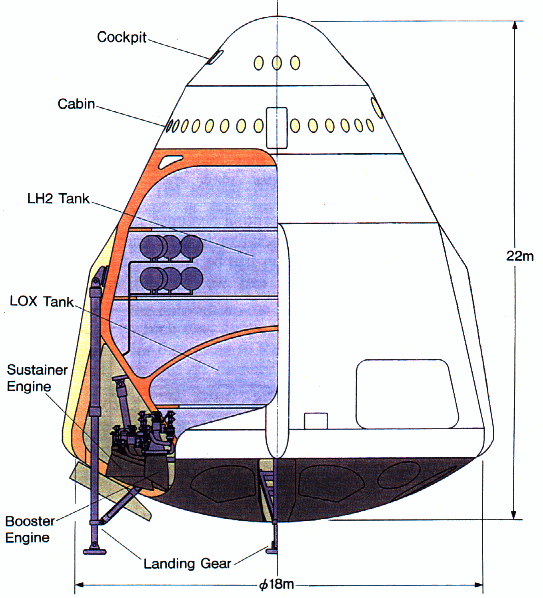 | |
|
The Kankoh-maru passenger spaceship being studied by the JRS
In the modern world, tourists account for more than 80 percent of air transport. Increasing demand from tourists lowers fares and expands the scale of the business, thereby allowing business customers also to enjoy the resulting benefits. The aviation industry and aircraft manufacturing are also beneficiaries. So shouldn't space transportation also be open to tourists, just as in the case of air transport? Couldn't this be promoted with a slogan such as "Let's solve global environmental problems by viewing them from space"? The "Kankoh-maru" spaceship design study being carried out under the auspices of the Japanese Rocket Society (JRS) is aimed at uncovering the people's potential demand for space travel, and making it technologically feasible. It is hoped that by the year 2009 we will be able to go on a sightseeing trip in space just as today we go sightseeing using aircraft. By that date, the fare for space transportation should have been cut to about one 100th of its present level. By that time also, substantial operating experience of the SPS 2000 system should have been accumulated. In this way we can look forward to yesterday's dreams becoming today's possibilities - and tomorrow's reality. "Dreams come true".
Great Expectations for the Space Solar Power Research Society
Professor Makoto Nagatomo
Researchers specializing in space tend to take a narrow view of things, although the subject they deal with is extremely large. Perhaps it is because they are so conscious of the limits of what they can do. When they are told that space is full of people's dreams, however, they may be driven to shrink their already narrow view even more, approachin surrealism. The majority of the "conceptual designs" of SPS drawn up by such space specialists in their study of space solar power generation can be compared to a story "What nice dreams can we conjure up?" 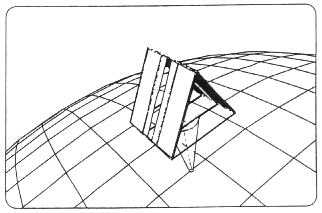 NASA's "Fresh Look" study of SPS, which was carried out recently, is like another peiformance of an outdated child's play when compared to the level of work being planned by this Society. To be honest, I must also be grouped among such space specialists. Fully aware of these bad traits, I have to confess the misery I feel about myself not knowing any other approach than this. Pressed to try some unprecedented project of highly difficult "Ultra-C" rating in order to win scientific research grants, we have chosen to ask for cooperation of specialists in other areas. With this, we hope we can obtain the momentum we need to advance. Professor Yoichi Kaya sald "Going to space requires a lot of energy and expenditure. Granting this research on SPS, however it is to be carried out, it cannot be successful without resolving this economic problem." This proposition is far beyond the realm of the child-like discussion of space specialists such as "Is it possible?" "Isn't it possible?" "What about this?" and "How about that?" I understand Professor Kaya's contention up to this point. However, this proposition is not appropriate as the theme for a study to receive scientific research grants. As is well known, the process of applying for scientific research grants is like the Tower of Babel, of which the top and the lower parts are perceptible only in blurred form. It was only recently that I learned that a research program of this kind would not be awarded with grants, although I had long suspected it. What then should be done? If researchers in each concerned area would conduct appropriate specialist research, I thought, the results of their research would then contribute to assessing the economic feasibility of SPS. In terms of rockets, my specialist area, we must prove the feasibility of reducing the cost of transporting SPS materials into space to an appropriate level. Likewise, researchers of solar cells may study the cost, production volume and life-time of solar cells to be used for SPS. Now that much experience has already been obtained of using solar cells for energy-generation on Earth, researchers in this field should be able to avoid the roundabout route we rocket engineers have to follow. However, pursuing the target of the economical operation of SPS in terms of transmitting electric power at competitive cost would not be so smooth. In view of the generation and transmission of electric power on Earth, however, at least the target for this research appears to be taking shape. Having said this, we may face contention that if researchers in each field work hard to make the most out of their own culture while upholding the above mentioned proposition, there is no need to have an organization such as the Space Solar Power Research Society. This is wrong, however. We must not forget that, although the areas of research are not the same, the target which researchers pursue should be a single system. For the time being, therefore, the Society's newsletter "SPS News" will play the role of linking the diversified research areas. It would be good also to organize meetings and a symposium for announcing research results. But it would not be useful for researchers to discuss issues of their respective fields of study alone in separate rooms. It would be better to organize a forum where speakers representing each area of study gather for discussion in the same room. I entertain great expectations for the new Society for providing researchers with a forum like this.
Comments on Participation in Eco-Japan '97 Held in Kyoto concurrently with COP 3
Yoshihiro NARUO
When the Kyoto conference on the prevention of global warming (officially, the Third Session of the Conference of the Parties to the United Nations Framework Convention on Climate Change (COP3)) was held in early December 1997, an international exhibition called "Eco-Japan '97" was held concurrently at the Kyoto Trade Fair Center. 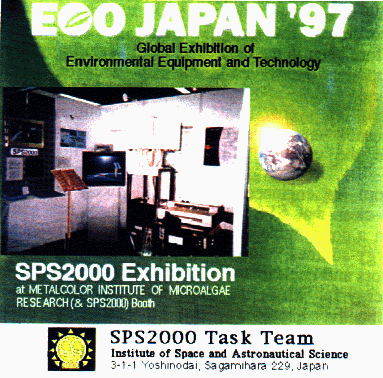 The exhibition was organized as an official event to go alongside the COP3 conference. Its leaflet says that the exhibition is "..aimed at introducing the participants in the COP3 conference and as many people as possible to the world's most advanced machines, equipment and technologies related to the saving of energy and environmental conservation, and that contribute to controlling global warming."Eco-Japan'97 was a reasonably large-scale exhibition with some three hundred booths. A total of 165 companies from 16 nations participated in the exhibition, while other participants included associations and other concerned organizations. Our research project, SPS 2000, also participated in the exhibition, advocating the need for SPS, though only in a modest way. I will use this opportunity to describe our activities at the exhibition. The reason why I use the phrase "in a modest way" is that we did not have an independent exhibition booth, but we managed to occupy only one third of the 2.5m x 3m space that the Kyoto prefectural government prepared for venture businesses. At the initial stage of negotiations over the exhibition, the functional model of "SPS 2000", which was spoken highly of when it was displayed for 6 months in Reunion museum in France, was to be put on display. Much to our regret, however, the exhibition organizer finally turned down the SPS 2000 model because of "lack of space." We have no means of knowing where and how adjustments were made. But initially, the official of the Kyoto Municipal Office, which was one of the organizers of the exhibition, had told us that the model was "a very good exhibit for the Kyoto conference." "If," he added, "sufficient space cannot be secured in the indoor exhibit area, we may consider building an open-air ad-hoc exhibit area (with funds provided by the municipal government)". We were unable to solve the riddle of what took place after this offer was cancelled, and we were about to abandon the idea of taking part in the exhibition at all. However, Professor Hideo Matsuoka, the Executive Chairperson of the Space Solar Power Research Society, suggested that this opportunity of demonstrating our endeavor should not be missed by any means, even if the space available was only very small. Finally, we were allowed to use part of the exhibition booth secured by Masaaki Iwabuchi, a member researcher of SPS 2000 who concurrently works for Metal Color Micro-Algae Research Institute. Placed on display were an English language video newly edited for Eco-Japan '97, severalpanels of explanation, and a rectenna model. As compared to the sales oriented exhibitions of manufacturers for their products in the other booths, our exhibition was unique in its demonstration of C02 fixation by using a metal color ultra-optical bio-converter, and making recommendations of what should be done and what not. This included, for instance, specifying what policies should be adopted at the COP3 conference, and specific technologies to be used for reduction of carbon dioxide emissions at the source. The fact that finally SPS 2000 obtained exhibition space in the venture business zone, it seems to me, was highly indicative of the likely future course of SPS development work.
Editorial - Widening the Base of SPS
The decision to establish the Space Solar Power Research Society on October 31, 1997 in Tokyo came about as the result of several years of work on SPS in several different research centers in Japan. This work had previously been loosely coordinated by the SPS Working Group based at the Institute for Space and Astronautical Science (ISAS). However, it came to be felt that the focus this put on the space engineering aspects of the project was no longer appropriate, and that the stage has now been reached where it is desirable to widen the range of different aspects of the project that are being considered professionally. To date, the majority of all work that has been done on SPS has concerned the design of the satellite, and has therefore been in the field of space engineering. And although unresolved problems still remain, it is becoming more and more widely accepted that a workable SPS system could be built - particularly once reusable launch vehicles are in operation that reduce the cost of launch to a reasonable level. Consequently, from the engineering point of view, it has become clear that SPS should now begin to be funded on a comparable basis to other non-fossil fuel energy-sources, such as "fast breeder" nuclear reactors and nuclear fusion, and as one form of solar energy for which the long term prospects are continually improving due to technological progress. However, when considered objectively, it is clear that research on the possibility of transmitting power from space to Earth is also desirable from several other points of view, not just that of engineering. Indeed, the possibility that power supplied from space may grow to become a major new energy source has wide implications for many aspects of life in modern society. But in order to bring this project to reality, experts in many different fields must start to study these issues seriously. The following is a brief summary of some of the issues in these fields.
Careful consideration of all these different implications of SPS research shows that it needs to be investigated over a far broader range of specialized fields than space engineering alone. It also suggests that SPS should be investigated with a reasonable level of resources. Making this case and building the necessary political support for SPS requires the cooperation of a wide range of specialists - business people, electricity industry experts, environmentalists, politicans, lawyers, economists, investors, and others. With the end of the "Cold War" the effectiveness of markets in achieving business growth is more widely appreciated (given the existence of an appropriate legal system, and social and monetary stability). With this in mind, it is hoped that the SPS 2000 pilot plant will be followed by other satellites being put in the same and/or other orbits to deliver power to the same rectennas. That is, once the system is established and operating, rectenna operators will be able to use additional supplies of microwave energy from space - and will be in a position to pay for them. In this way, SPS 2000 may create a real market - the first - for microwave energy from space. And once a market arises for power from space, it can grow spontaneously, attracting investors to generate further growth - but the first market needs some more help to start. | |
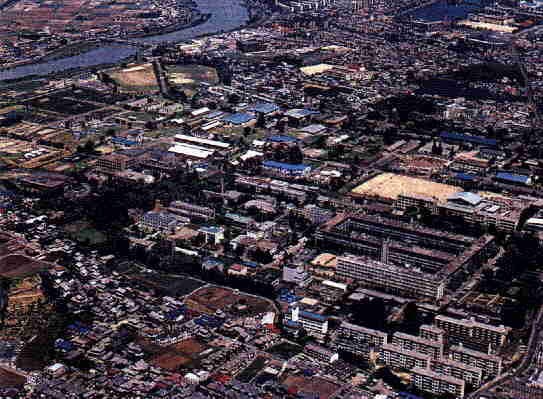 | |
|
The Uji Campus of the University of Kyoto, where the Radio Atmospheric Science Center (RASC) is led by Professor Hiroshi Matsumoto.
Many wireless power transmission (WPT) and reception experiments have been carried out by Professor Matsumoto's research group, and a new laboratory for high power microwave transmission experiments, METLAB, has recently been built in the center.
Glossary of terms used
Next issue, June 1998:
For correspondence, contributions or further information, please contact Patrick Collins at: Research Center for Advanced Science & Technology, University of Tokyo, 4-6-1 Komaba, Meguro-ku, Tokyo 153, Japan.
| |


